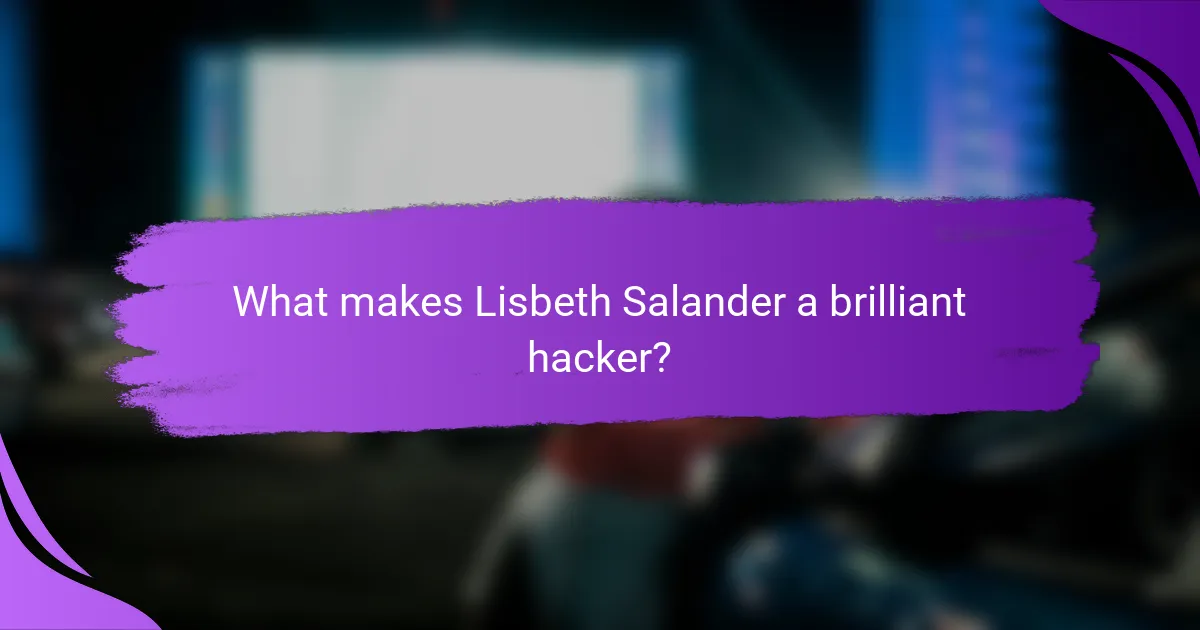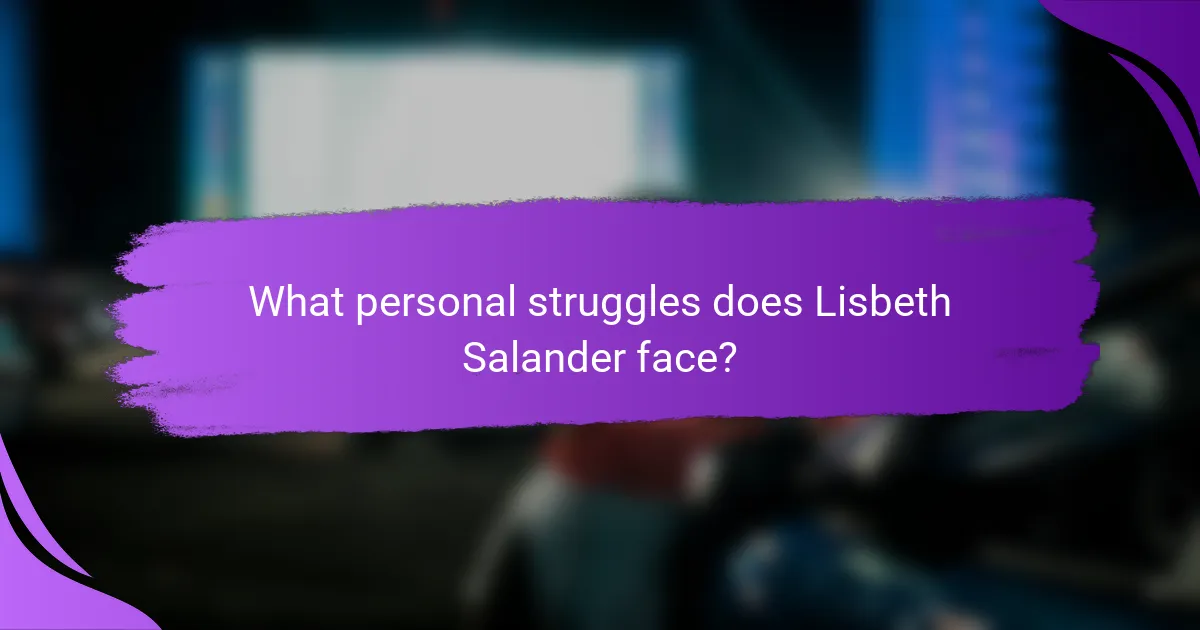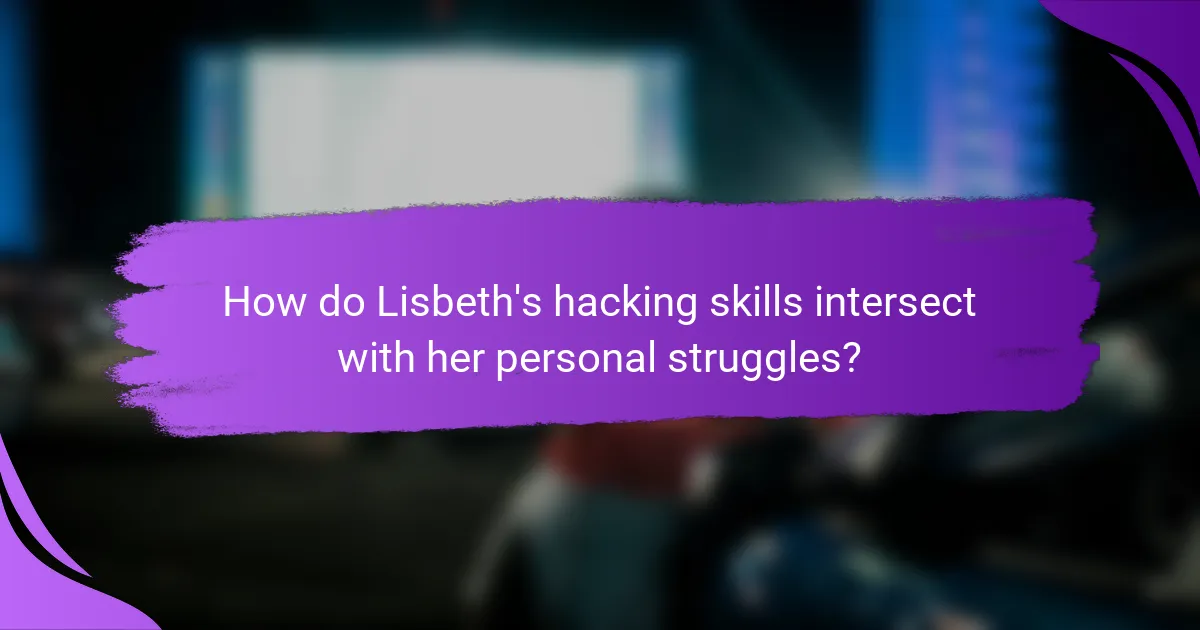Lisbeth Salander is a highly skilled hacker known for her exceptional analytical abilities and deep understanding of technology. Her expertise encompasses advanced programming, data manipulation, and a keen awareness of cybersecurity vulnerabilities, all of which contribute to her reputation in the hacking community. However, Salander’s personal struggles, including childhood trauma, social isolation, and mental health issues, profoundly impact her life and relationships. Her hacking skills serve as a coping mechanism, providing her with a sense of agency and empowerment while she seeks justice against societal injustices. This article explores the intricate connection between Salander’s technical prowess and her personal challenges, highlighting her resilience in the face of adversity.

What makes Lisbeth Salander a brilliant hacker?
Lisbeth Salander is a brilliant hacker due to her exceptional analytical skills and deep understanding of technology. She possesses an innate ability to quickly assess complex systems. Salander’s expertise includes advanced programming and data manipulation techniques. Her photographic memory allows her to recall intricate details effortlessly. Additionally, she demonstrates strong problem-solving skills under pressure. Salander’s unconventional thinking enables her to approach challenges from unique angles. Her experience with hacking is complemented by her knowledge of cybersecurity vulnerabilities. These attributes collectively contribute to her reputation as a highly skilled hacker.
How does Lisbeth’s background influence her hacking skills?
Lisbeth’s background significantly influences her hacking skills. She experienced severe trauma and neglect during her childhood. This led her to develop resilience and a strong sense of independence. Her difficult upbringing fostered her ability to think critically and solve problems creatively. Lisbeth’s exposure to a harsh environment made her adept at navigating complex systems. She learned to rely on her intelligence and resourcefulness. Additionally, her experiences with authority figures fueled her distrust of institutions. This distrust drives her to expose corruption through her hacking. Her unique combination of skills and experiences makes her an exceptional hacker.
What personal experiences shape her technical abilities?
Lisbeth Salander’s technical abilities are shaped by her traumatic childhood experiences and extensive self-education. She faced severe abuse and neglect, which fostered her resilience and survival instincts. This environment led her to develop exceptional analytical skills and a deep understanding of technology. Salander’s experiences with oppressive systems motivated her to master hacking as a means of empowerment. Additionally, her time working with a private investigator provided practical experience in cybersecurity and data retrieval. These personal challenges and professional opportunities combined to refine her skills and enhance her technical prowess.
How does her upbringing contribute to her mindset as a hacker?
Lisbeth Salander’s upbringing significantly shapes her mindset as a hacker. She experienced neglect and abuse during her childhood. This harsh environment fostered resilience and a strong sense of independence. Salander learned to rely on her intelligence and resourcefulness to survive. Her early exposure to technology, particularly through her father’s criminal activities, sparked her interest in hacking. Additionally, her experiences with injustice fueled her desire to fight against corruption. Salander’s upbringing instilled in her a distrust of authority, motivating her to seek truth through unconventional means. Ultimately, her difficult past is a catalyst for her exceptional skills and determination as a hacker.
What are the key hacking techniques employed by Lisbeth Salander?
Lisbeth Salander employs several key hacking techniques. She utilizes social engineering to manipulate individuals into revealing sensitive information. Salander also excels in exploiting vulnerabilities in computer systems. She frequently employs brute force attacks to crack passwords. Additionally, she uses encryption and decryption methods to secure her communications. Salander’s ability to analyze data enables her to uncover hidden patterns. She often employs malware to infiltrate systems undetected. Her skills in network [censured] allow her to access restricted areas of databases. These techniques showcase her expertise as a hacker in “The Girl with the Dragon Tattoo.”
How does she utilize social engineering in her hacking?
Lisbeth Salander utilizes social engineering by manipulating human psychology to gain unauthorized access to information. She often researches her targets to understand their behaviors and vulnerabilities. Salander employs tactics such as impersonation and deception to trick individuals into revealing sensitive data. For example, she may pose as a legitimate authority figure to extract passwords or confidential information. Her ability to read social cues enhances her effectiveness in these scenarios. This approach allows her to bypass technical security measures that would typically protect data. Salander’s success in social engineering is evidenced by her ability to infiltrate secure systems without traditional hacking tools.
What software and tools does she prefer for her hacking endeavors?
Lisbeth Salander prefers software and tools like Linux, specifically the Kali distribution, for her hacking endeavors. She utilizes various hacking tools such as Metasploit for [censured] testing and Wireshark for network analysis. Salander also employs custom scripts and programming languages like Python to automate tasks. Her proficiency in these tools is depicted throughout “The Girl with the Dragon Tattoo.” The narrative illustrates her exceptional skills in exploiting vulnerabilities and executing complex hacking operations.

What personal struggles does Lisbeth Salander face?
Lisbeth Salander faces significant personal struggles including trauma from her childhood abuse. She is a survivor of severe neglect and violence, which impacts her ability to trust others. Salander also deals with social isolation due to her unconventional behavior and lifestyle. Her struggles with mental health are evident, as she exhibits symptoms of PTSD and anxiety. Furthermore, she grapples with societal judgment and discrimination, particularly regarding her appearance and demeanor. These challenges shape her interactions and relationships throughout the narrative. Salander’s resilience in overcoming these struggles is a central theme in her story.
How do her past traumas affect her relationships?
Her past traumas significantly impact her relationships. Lisbeth Salander’s history of abuse leads to trust issues. She often struggles to connect emotionally with others. This detachment can manifest as coldness or aggression. Her experiences create barriers to intimacy. For instance, her relationship with Mikael Blomkvist is complicated by her reluctance to open up. Research indicates that trauma can lead to attachment disorders. These disorders affect how individuals perceive and engage in relationships. Lisbeth exemplifies this through her defensive behavior and reluctance to rely on others.
What specific events contribute to her emotional challenges?
Lisbeth Salander’s emotional challenges stem from several specific events. Childhood trauma significantly impacts her psyche. She faced severe abuse from her father, which created deep-rooted trust issues. Additionally, her experiences in a psychiatric institution further compounded her emotional struggles. Salander was subjected to mistreatment and lack of autonomy during her time there. These events contribute to her complex personality and emotional responses throughout the narrative. The cumulative effect of these traumas manifests in her difficulty forming relationships and coping with authority.
How does she cope with her psychological struggles throughout the story?
Lisbeth Salander copes with her psychological struggles through various mechanisms. She employs hacking as a means of empowerment and control. This skill allows her to reclaim her autonomy in a world that often seeks to subjugate her. Salander also utilizes her intelligence and resourcefulness to navigate challenging situations. She builds a network of relationships, albeit selectively, which provides her with support. Additionally, she channels her trauma into motivation for justice. Her resilience is evident as she confronts her past and seeks retribution against those who wronged her. Throughout the story, these coping strategies illustrate her complex character and determination.
What role does her resilience play in overcoming obstacles?
Her resilience is crucial for overcoming obstacles. It enables her to endure and navigate challenges effectively. Resilience allows her to recover from traumatic experiences. This quality helps her maintain focus on her goals despite adversity. For instance, she faces significant personal and societal barriers. Each challenge strengthens her determination. Research shows that resilience can lead to better problem-solving abilities. This is evident in her strategic approach to hacking and investigation.
How does her determination manifest in her actions?
Lisbeth Salander’s determination manifests in her relentless pursuit of justice. She meticulously investigates cases, often risking her safety. Salander uses her hacking skills to uncover hidden truths. This technical expertise demonstrates her commitment to exposing corruption. She confronts powerful adversaries without hesitation. Salander’s resilience is evident in her ability to recover from trauma. Her actions reflect an unwavering focus on her goals. Ultimately, her determination drives her to challenge societal norms and fight for the oppressed.
What strategies does she use to confront her fears?
Lisbeth Salander confronts her fears through systematic desensitization and cognitive restructuring. She faces her traumatic memories by revisiting them in controlled environments. This approach helps her reduce anxiety associated with those memories. Additionally, she utilizes her hacking skills to gain control over situations that intimidate her. By gathering information, she empowers herself against perceived threats. These strategies are evident in her interactions with antagonists. They demonstrate her ability to manage fear effectively. Salander’s methods reflect psychological principles used in therapy to address trauma and anxiety.

How do Lisbeth’s hacking skills intersect with her personal struggles?
Lisbeth’s hacking skills are deeply intertwined with her personal struggles. Her exceptional abilities serve as a coping mechanism for her traumatic past. Hacking allows her to regain control in a world where she often feels powerless. It provides her with a sense of agency and independence. Additionally, her skills enable her to expose corruption and seek justice. This pursuit is a reflection of her own experiences with victimization. The challenges she faces in her personal life fuel her determination to fight back against societal injustices. Ultimately, her hacking is both a form of survival and a means of empowerment in the face of adversity.
In what ways does hacking serve as a coping mechanism for Lisbeth?
Hacking serves as a coping mechanism for Lisbeth by providing her a sense of control. It allows her to reclaim power in situations where she feels vulnerable. Through hacking, Lisbeth can navigate her traumatic past and confront her adversaries. The act of hacking offers her a distraction from emotional pain. It also enables her to seek justice for herself and others. Additionally, hacking fosters a sense of identity and belonging in a world where she feels isolated. This digital realm allows her to express her intelligence and skills. Overall, hacking is integral to her survival and self-empowerment.
How does her technical prowess empower her in difficult situations?
Lisbeth Salander’s technical prowess empowers her by enabling her to solve complex problems quickly. Her hacking skills allow her to access critical information that others cannot. This capability provides her with leverage in dangerous situations. For instance, she uncovers hidden truths about corrupt individuals. Her expertise in cyber security helps her protect herself from threats. Salander’s ability to manipulate technology gives her an edge in confrontations. This technical skill set is crucial for her survival and success. Overall, her prowess transforms challenges into opportunities for resolution.
What parallels exist between her hacking and her personal battles?
Lisbeth Salander’s hacking parallels her personal battles through themes of control and empowerment. In her hacking, she seeks to regain control over her life and expose corruption. This mirrors her personal struggles against abuse and systemic oppression. Both her hacking and personal battles highlight her resilience and resourcefulness. Salander uses her skills to navigate and dismantle oppressive systems. Her hacking serves as a form of rebellion against her traumatic past. Each act of hacking symbolizes her fight for justice and autonomy. Ultimately, both aspects reveal her determination to reclaim power in a world that seeks to undermine her.
What can we learn from Lisbeth Salander’s character?
Lisbeth Salander’s character teaches resilience and the importance of independence. She embodies strength through her ability to overcome trauma. Salander’s skills in hacking demonstrate the power of intelligence and resourcefulness. Her refusal to conform to societal norms highlights the value of authenticity. Additionally, her complex relationship with trust illustrates the challenges of vulnerability. Salander’s journey emphasizes the significance of justice and fighting against oppression. Her character encourages self-advocacy and standing up for oneself. Overall, Lisbeth Salander represents the multifaceted nature of personal strength and the fight for truth.
How can her story inspire resilience in real-life challenges?
Lisbeth Salander’s story exemplifies resilience through her ability to overcome severe adversity. She faces trauma, betrayal, and systemic injustice. Despite these challenges, she remains determined and resourceful. Her hacker skills symbolize her fight against oppression. This determination inspires individuals to confront their own struggles. Resilience is shown in her refusal to be defined by her past. Salander’s story encourages others to harness their inner strength. Her journey illustrates that perseverance can lead to empowerment and justice.
What lessons about empowerment and self-reliance can be drawn from her journey?
Lisbeth Salander’s journey illustrates the importance of empowerment and self-reliance. She demonstrates that overcoming adversity can lead to personal strength. Salander’s experiences with trauma and injustice fuel her drive for independence. Her hacking skills symbolize her ability to reclaim control over her life. She relies on her intelligence and resourcefulness to navigate challenges. Salander’s defiance against oppressive systems showcases resilience. Her story emphasizes the value of self-advocacy in achieving justice. Ultimately, her journey inspires others to pursue autonomy and assert their rights.
The main entity of this article is Lisbeth Salander, a character known for her exceptional hacking abilities and complex personal struggles in “The Girl with the Dragon Tattoo.” The article explores the attributes that contribute to her brilliance as a hacker, including her analytical skills, technical knowledge, and unique problem-solving approaches. It also examines how her traumatic upbringing influences her mindset and coping mechanisms, shaping her resilience and determination. Key hacking techniques employed by Salander, such as social engineering and exploiting system vulnerabilities, are highlighted alongside the personal challenges she faces, emphasizing the intersection of her skills and struggles. Ultimately, the article illustrates the themes of empowerment, self-reliance, and the pursuit of justice through Salander’s character.